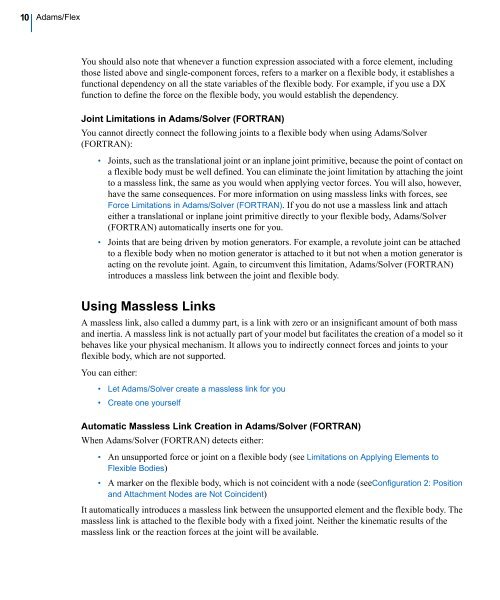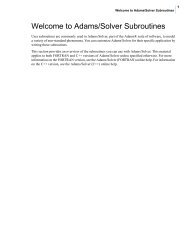Building Flex Body Models - Kxcad.net
Building Flex Body Models - Kxcad.net
Building Flex Body Models - Kxcad.net
You also want an ePaper? Increase the reach of your titles
YUMPU automatically turns print PDFs into web optimized ePapers that Google loves.
10<br />
Adams/<strong>Flex</strong><br />
You should also note that whenever a function expression associated with a force element, including<br />
those listed above and single-component forces, refers to a marker on a flexible body, it establishes a<br />
functional dependency on all the state variables of the flexible body. For example, if you use a DX<br />
function to define the force on the flexible body, you would establish the dependency.<br />
Joint Limitations in Adams/Solver (FORTRAN)<br />
You cannot directly connect the following joints to a flexible body when using Adams/Solver<br />
(FORTRAN):<br />
• Joints, such as the translational joint or an inplane joint primitive, because the point of contact on<br />
a flexible body must be well defined. You can eliminate the joint limitation by attaching the joint<br />
to a massless link, the same as you would when applying vector forces. You will also, however,<br />
have the same consequences. For more information on using massless links with forces, see<br />
Force Limitations in Adams/Solver (FORTRAN). If you do not use a massless link and attach<br />
either a translational or inplane joint primitive directly to your flexible body, Adams/Solver<br />
(FORTRAN) automatically inserts one for you.<br />
• Joints that are being driven by motion generators. For example, a revolute joint can be attached<br />
to a flexible body when no motion generator is attached to it but not when a motion generator is<br />
acting on the revolute joint. Again, to circumvent this limitation, Adams/Solver (FORTRAN)<br />
introduces a massless link between the joint and flexible body.<br />
Using Massless Links<br />
A massless link, also called a dummy part, is a link with zero or an insignificant amount of both mass<br />
and inertia. A massless link is not actually part of your model but facilitates the creation of a model so it<br />
behaves like your physical mechanism. It allows you to indirectly connect forces and joints to your<br />
flexible body, which are not supported.<br />
You can either:<br />
• Let Adams/Solver create a massless link for you<br />
• Create one yourself<br />
Automatic Massless Link Creation in Adams/Solver (FORTRAN)<br />
When Adams/Solver (FORTRAN) detects either:<br />
• An unsupported force or joint on a flexible body (see Limitations on Applying Elements to<br />
<strong>Flex</strong>ible Bodies)<br />
• A marker on the flexible body, which is not coincident with a node (seeConfiguration 2: Position<br />
and Attachment Nodes are Not Coincident)<br />
It automatically introduces a massless link between the unsupported element and the flexible body. The<br />
massless link is attached to the flexible body with a fixed joint. Neither the kinematic results of the<br />
massless link or the reaction forces at the joint will be available.















